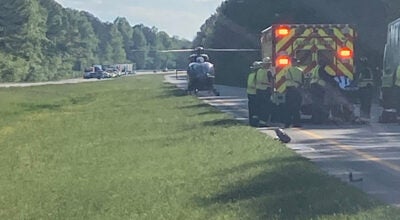Walmart thefts drive up crime rate
Published 8:33 pm Saturday, February 23, 2013
During a police interview, Yolanda Chapman estimated she had smoked $300 to $400 of crack cocaine before allegedly stealing two air-conditioning units from Suffolk’s Main Street Walmart, court records state.
Chapman, 44, claimed she didn’t know the identity of her smoking buddy who, later that March day in 2012, dropped her at the store and allegedly asked her to place the units in a cart and push them through the garden center and past the checkouts, without paying.
“I mean, I have got high with him, and that’s all I know,” she told her interviewer, according to a transcript. “I was in the house getting high, and that’s it. … He had transportation.”
Chapman, indicted last August by grand jury on three felony charges — two larceny-related and failing to appear in court — is scheduled for a Circuit Court trial in front of a judge in March.
She’s allegedly among a group of Walmart marauders responsible for a spike in Part 1 offenses — murder, aggravated assault, rape, robbery, larceny, motor vehicle theft and arson — in Suffolk in 2012.
Thefts from the city’s two Walmarts, federal and local law enforcement authorities report, accounted for all but 10 of 231 recorded larcenies in Suffolk in 2012, which increased 13.2 percent from 2011.
Without the Walmart crimes, authorities say, Part 1 offenses in Suffolk would have actually fallen 16 percent instead of climbing 3.4 percent.
Walmart has “significantly increased” asset protection staff at its two Suffolk stores, company spokeswoman Dianna Gee confirmed. Police Chief Thomas Bennett said this is the main reason Walmart thefts figure so heavily in crime figures.
“People are stealing more with the economy and not having jobs,” he said. “I can’t prove it, but that’s what I believe.”
On the enforcement point, Gee elaborated that stores have specialized teams “dedicated to specifically identifying and detecting shoplifting.”
As well as Walmart’s 24/7 trading and large volume of customer traffic, she also pointed to “something that all retailers face … organized retail crime.”
Suffolk’s Commonwealth’s Attorney, Phil Ferguson, professed he is “amazed what I see sometimes” when it comes to organized shoplifting.
“Some take a full cart and just push them through the door,” while accomplices act as lookouts and getaway-car drivers, he said. “They are very brazen.”
Criminal groups targeting Walmart often journey from one side of Hampton Roads to another, either singling out what they believe is an easier store or hitting several in an outing, he said.
Of 125 retailers surveyed last year by the National Retail Federation, 96 percent, up from 94.5 percent in 2011, claimed to have been victims of organized retail crime in the past year.
Furthermore, 87.7 percent said the crime sub-category had grown in the U.S. during the past three years.
Expanding on Ferguson’s observations, Richard T. Mellor, the federation’s vice president of loss prevention, said organized retail criminals often have very specific roles when hitting major stores like Walmart.
One criminal, for instance, gathers together dissimilar products from different areas of the store, such as men’s polo shorts and women’s designer jeans, he said.
Another criminal will bundle the grouped merchandise into carts and take it to the parking lot, where yet another has the specific task of transferring it to a vehicle whose driver’s job is also assembly line-like, he added.
“It makes it difficult for prosecution. … They might catch the driver of the van, but the driver of the van says, ‘I didn’t steal this merchandise; what are you talking about?’” he said.
Retail companies, despite being market competitors, have united against their organized foes by themselves organizing, while also investing in technology, according to Mellor.
“They have really invested a significant amount of money in electronic gear that helps them collect information and video surveillance, which is transferred quickly to law enforcement … and retailers in the neighboring area,” he said.
Companies collaborate and share information within “25 to 30” crime taskforces across the United States, Mellor estimated. One operating in Hampton Roads — though Walmart is not a member — meets in Norfolk the fourth Tuesday of every month.
Chief Bennett said his department, whose focus at any given time is guided by crime trends, is developing a plan to fight the rising number of Walmart larcenies. “A big part of that is going to be working with Walmart stores,” he said.
Thirty-four days ago, Yolanda Chapman, who has been in Western Tidewater Regional Jail since Dec. 3, used prison-issue pencil and paper to write authorities a letter requesting a bond hearing at which she would represent herself.
According to the interview transcript, she told police: “They told me they were paying” for the air conditioners and “they told me to push it (the cart) out.”
But her crack-smoking partner, she also told them, said he was going to “take them back in and get the money.”






